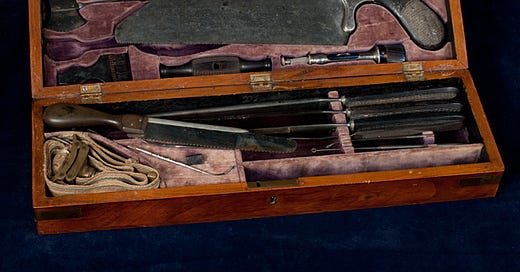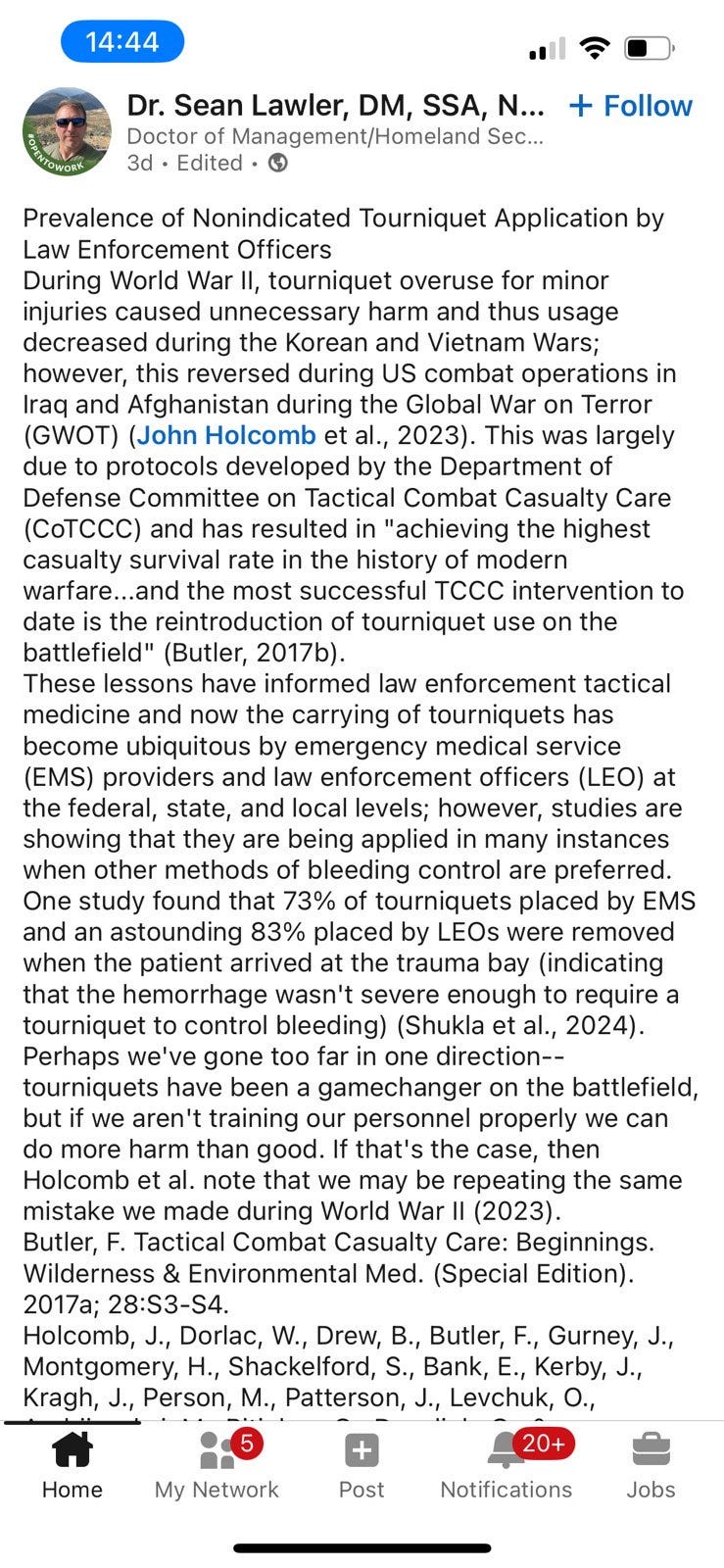Few medical tools have changed outcomes—at least anecdotally—as dramatically as the modern tourniquet. Once reserved for the battlefield or operating room, tourniquets are now part of everyday preparedness. They’re worn on the duty belts of police officers, tucked into range bags at local shooting ranges, and even stashed in the purses of prepared moms.
My earliest hands-on encounter with a tourniquet came when I was young, while rummaging through old family heirlooms in the basement. I discovered a small, polished wooden box containing a set of hand saws, some scalpels, and a metal device with a crank and a cotton band. It turned out to be a Civil War-era amputation kit— and what passed for a tourniquet at the time. It looked like a prop straight out of the movie Saw.
Tourniquet and first aid was taught during Basic Training, and was regularly reinforced throughout my service. Back then, the tourniquet was considered a last-ditch, “Hail Mary” intervention for a soldier bleeding out from extremity wounds—typically gunshots, landmines, or other traumatic injuries. We were trained to tie a cravat (a triangular bandage) around the limb, secure it with an overhand knot, insert a rifle cleaning rod or stick through the knot, and twist until it tightened. Then, we’d tie off the rod and mark the time of application on the patient’s forehead in their own blood. We were told this procedure would almost certainly cost the limb, but it could save a life. Not much more refined—or effective—than that Civil War box of saws and scalpels in my basement.
Fast-forward to the early years of the Global War on Terror, post-9/11. Our military once again faced the brutal realities of modern combat, and it became evident that many soldiers were dying from extremity hemorrhaging—gunshots, landmines, IEDs. But unlike prior conflicts, every soldier now wore ballistic helmets and vests. These advances reduced deaths from the most immediate life-threatening injuries to the head and torso, which in turn began skewing the data on tourniquet effectiveness.
Even in Vietnam, despite the prevalence of extremity injuries, most fatalities were from head, neck, thoracic, or abdominal wounds. According to Wound Data and Munitions Effectiveness Team (WDMET) data, extremity injuries made up 60% of wounds, but only 7–10% of deaths. Head and neck wounds accounted for 40% of fatal injuries, while torso wounds contributed 30–40%.
Looking at Iraq and Afghanistan, the expectation was that fatality patterns would shift with improved protective gear and battlefield care. However, the numbers remained surprisingly similar. Extremity wounds still accounted for about 50–60% of all injuries but only 7–10% of deaths, while head and torso injuries remained the leading causes of mortality. Statistically, not much had changed.
Still, tourniquets gained near-mythical status. The stories of lives saved in combat began to overshadow the data, fueling a cultural shift. More than in any previous war, our civilian world absorbed the habits and gear of our warfighters. AR-15s, tacti-cool clothing, and medical gear—especially tourniquets—exploded in popularity. The once-rare device became ubiquitous in pre-hospital EMS, law enforcement, and the “tactical” community.
Now that we have more data, we’re starting to see the darker side of this trend. Overuse of tourniquets has real medical and financial consequences.
Many of these cases originate from law enforcement encounters where officers, trained under Tactical Combat Casualty Care (TCCC) “Care under fire” doctrine, apply tourniquets for any bleeding extremity, regardless of severity. Unfortunately, this overapplication causes two major issues:
1. Medical Harm:
Some tourniquets are simply unnecessary, causing additional pain and trauma. Worse, many are applied incorrectly—tight enough to restrict venous outflow but not arterial inflow—leading to early stages of compartment syndrome and neurological damage.
2. Financial Cost:
When a patient arrives at an emergency room with a tourniquet, the case is automatically escalated to—“code red” or equivalent. Surgeons, imaging, trauma specialists—all are mobilized. Resources are diverted from more urgent needs, and the patient is billed for every moment. In today’s healthcare system, hospitals are incentivized to generate revenue. A patient, unfortunately, is often little more than a self-admitting ATM and one that comes in with an unnecessary tourniquet is no exception. Once you roll into that trauma bay you’re going to have a big financial bomb dropped on you, even for a “flesh wound”.
What prompted this essay was a message in a chat group from my friend James, a Physicians Assistant working, and teaching, in Africa. (If you’re not already following his Substack, Wilderness PA, you should be.) He shared a study in response to an ongoing discussion that he and I, and another friend, Pete, who is also a PA who works in a couple of the busiest emergency departments in Phoenix, had been having for some time. Both James and Peter are also paramedics with significant street experience and members of the same Mountain Rescue team with which I served. The article highlighted exactly what we’ve been discussing—tourniquet overuse and its impact.
Pete, during our ongoing discussions, following a shift in the ED, often lamented about “another cop putting a TQ on a boo-boo”. He made it quite clear that few, if any, of the tourniquet applications were necessary and most were done incorrectly, so much so that a real life threatening bleed wouldn’t have been resolved, and some causing unnecessary injury. Each with a high cost, medically and financially, to the patient.
Digging into the literature, I found a treasure trove of studies confirming this trend: inappropriate and unnecessary application of tourniquets in pre-hospital care, with harmful consequences. Even respected journals like JEMS (Journal of Emergency Medical Services) have recently addressed the issue.
So what do we do?
We start by teaching the full context—not just “high and tight” but why, when, and how to use a tourniquet. We must ask: “Is what I’m doing actually helping the patient?” If the answer is no, it’s time to take a breath and find a better solution. We need to teach that there are other tools available and that, although not quite as sexy, may be more effective or appropriate. I mean, who wants to see a package of gauze on someone’s gun belt? There’s no flex in that!
One shining example of this is in the wilderness medicine curriculum as there must be a pragmatic approach to caring for injuries because, as we said while I was serving with Mountain Rescue, “if I’m your medic you don’t just have a medical problem, you have a location problem”. Much of our care was in remote and austere locations, often hours, and potentially a day, or days, away from definitive care. Placing a tourniquet on someone, even if they are currently suffering from a life threatening bleed, meant that the potential for greater harm had to be considered and “tourniquet conversion” was established in our protocol. Conversion is when one modality, such as a tourniquet, is re-evaluated and, if able, removing it in place of a pressure dressing or other less invasive tool. This, of course, can, and should, go the other way. Start with pressure and proper bandaging, and if the bleeding continues, or gets worse, step up to a TQ. This is done not only for patient comfort but because long term application of a tourniquet can lead to significant injury to the patient.
We can also engage with our peers. Many people carrying tourniquets have received little or no formal training—or perhaps worse, training that treats the tourniquet as a one-size-fits-all fix. For example, the flowchart from Binghamton University’s Stop the Bleed page easily implies that nearly any bleeding wound warrants a tourniquet:
Binghampton University STB flowchart
Let’s be clear: not all bleeding is life-threatening. Before you reach for a tourniquet, learn what a true arterial, or significant venous bleed, looks like. I demonstrate this by showing my students what different volumes of “blood” (fake blood/colored water) looks like when it is poured on the ground. Many will see small amounts, often as little as that which is exsanguinated during a visit to the blood bank, and consider it to be a life threatening amount, especially if they envision it coming from their body. Having a solid understanding of how much is too much, and how fast is too fast, is critical. I will note that erring on the side of caution, especially if alone, is not unwise. You can always convert to a lower level of tool. There are many great educational videos online—YouTube, and, of course, WorldStar are great resources.
Mountain bike crash - femoral artery
In Conclusion:
My goal isn’t to vilify the tourniquet—it’s a lifesaving tool. But like many tools in medicine and self-defense, it's often seen as a panacea. We must move beyond binary choices—and need skills that lie somewhere between rubbing dirt on it and strapping on a tourniquet—and embrace the space between. Most of the time, neither is the right answer.
Postscript:
I can’t emphasis the very real need for, at least, Stop the Bleed training. My personal, and professional, opinion is that anyone who works with sharp tools, whether at home, or at the jobsite, and anyone who shoots either bullet or arrow must have not just the tools, but the knowledge, skills and experience to use any field-available medical tool correctly and effectively. If you don’t I don’t really want to be on the range with you.
Your Defense is Personal
Learn more about SafeMind and the training that we provide at SafeMind LLC, including Stop the Bleed, wilderness and tactical medicine.








This is a fascinating piece that has made me rethink a lot of things. I trained as an EMT in Belgium in the early 2000s. We were told to stay away from tourniquets because we could call in a medical team, including an ER doctor and nurse, to back us up for the extreme stuff. Given the country's size and population density, they could be on the scene within minutes. I started seeing Tourniquets everywhere when I moved to the US 10 years ago. I assumed I had gotten it all wrong. After reading this, I realize I will need to do a lot more thinking. This was a "today years old" experience. Thank you!